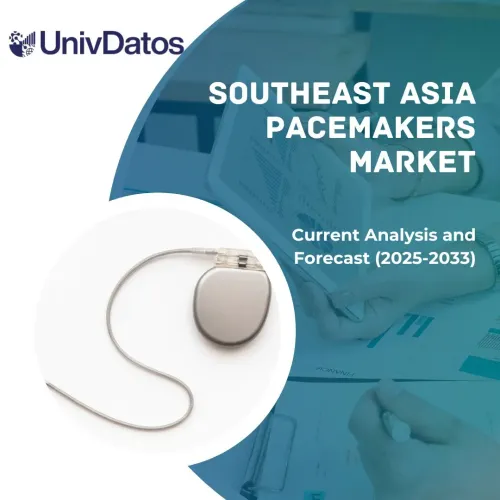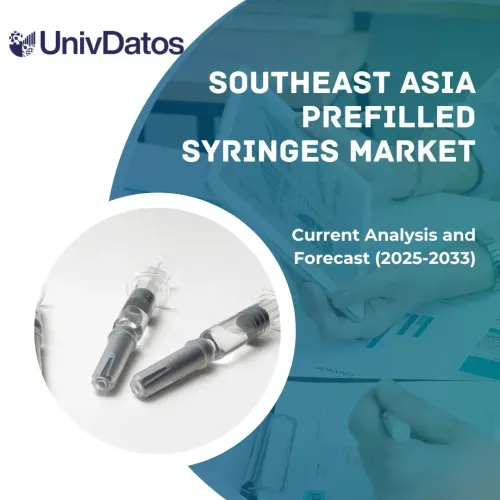- Home
- About Us
- Industry
- Services
- Reading
- Contact Us
Colony-Stimulating Factor Therapy Market: Current Analysis and Forecast (2024-2032)
Emphasis on Type (Macrophage–Colony-Stimulating Factor (M-CSF), Multiple-Colony-Stimulating Factor, or Interleukin 3 (IL-3), Granulocyte-Macrophage–Colony-Stimulating Factor (GM-CSF), Granulocyte–Colony-Stimulating Factor (G-CSF)); Drug (Pegfilgrastim, Tbo-filgrastim, Sargramostim, Filgrastim, Others); Application (Aplastic Anemia, Bone Marrow Transplantation, Neutropenia, Neutropenia Associated with Chemotherapy, Neutropenia Associated with Radiation, Peripheral Progenitor Cell Transplantation); End-User (Hospitals, Specialty Clinics, Homecare, Others); Distribution channel(Hospital Pharmacies, Retail Pharmacies, Online Pharmacies); Region/Country.
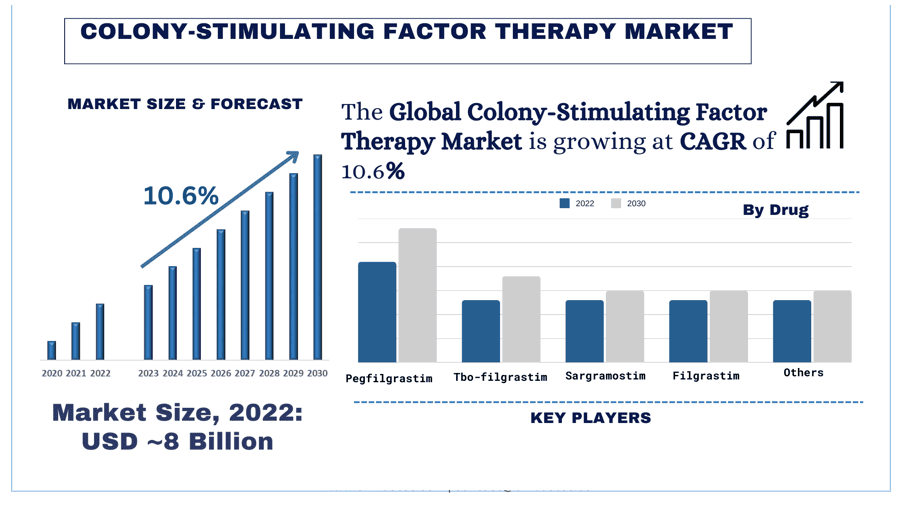
Colony-stimulating factor therapy Market Size & Forecast
The Colony-stimulating factor therapy Market was valued at USD ~8 Billion and is expected to grow at a strong CAGR of around 10.6% during the forecast period (2024-2032) owing rising prevalence of Cancer.
Colony-stimulating factor therapy Market Analysis
The colony stimulating factor (CSF) therapy market refers to the segment of the pharmaceutical industry focused on the development, production, and sale of medications known as colony stimulating factors. These medications are used to stimulate the production of white blood cells (specifically granulocytes, macrophages, and platelets) in patients whose immune systems are compromised due to conditions such as cancer, chemotherapy, bone marrow transplant, or certain infections. As the incidence of cancer continues to rise globally, the demand for colony stimulating factors, which are often used as supportive care in cancer treatment to manage chemotherapy-induced neutropenia, is also increasing. For instance, according to PAHO, in 2023, Globally, there were an estimated 20 million new cases of cancer and 10 million deaths from cancer. The cancer burden will increase by approximately 60% over the next two decades, further straining health systems, people and communities.
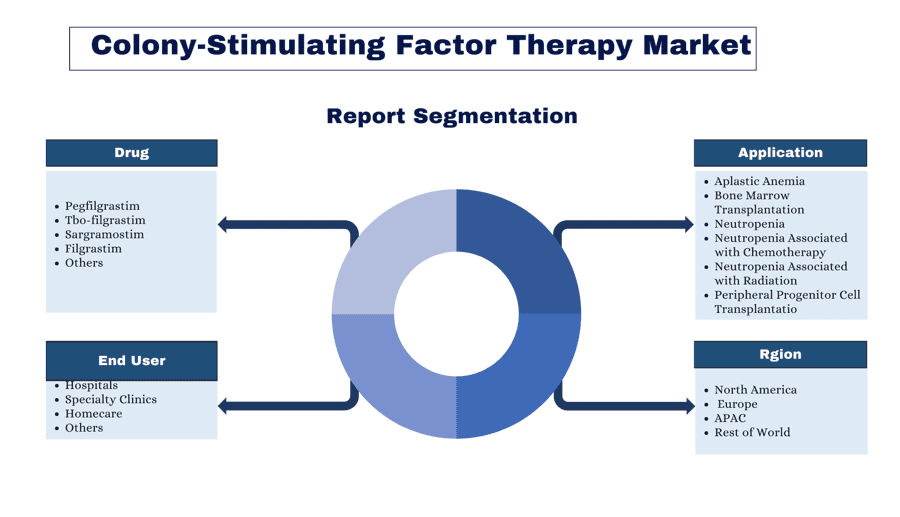
Colony-stimulating factor therapy Market Trends
This section discusses the key market trends that are influencing the various segments of the Colony-stimulating factor therapy Market as identified by our team of research experts.
Hybrid Prosthetic Devices Transforming Industry
Advancements in Biotechnology and Drug Development: Biotechnology is playing a pivotal role in the development of novel CSF therapies with enhanced efficacy and safety profiles.
Researchers are leveraging cutting-edge techniques such as protein engineering, glycoengineering, and recombinant DNA technology to design next-generation CSF products.
By optimizing the structure and function of CSFs, biotechnology advancements aim to improve pharmacokinetics, reduce immunogenicity, and enhance therapeutic outcomes for cancer patients.
Personalized Medicine and Biomarker-driven Treatment: Personalized medicine approaches are gaining traction in the CSF therapy market, with a focus on tailoring treatment strategies to individual patient characteristics.
Biomarker-driven treatment algorithms help identify patients who are most likely to benefit from CSF therapy based on genetic, molecular, and clinical factors.
By matching patients with the most appropriate CSF therapy, personalized medicine approaches optimize treatment response rates, minimize adverse effects, and improve overall survival outcomes.
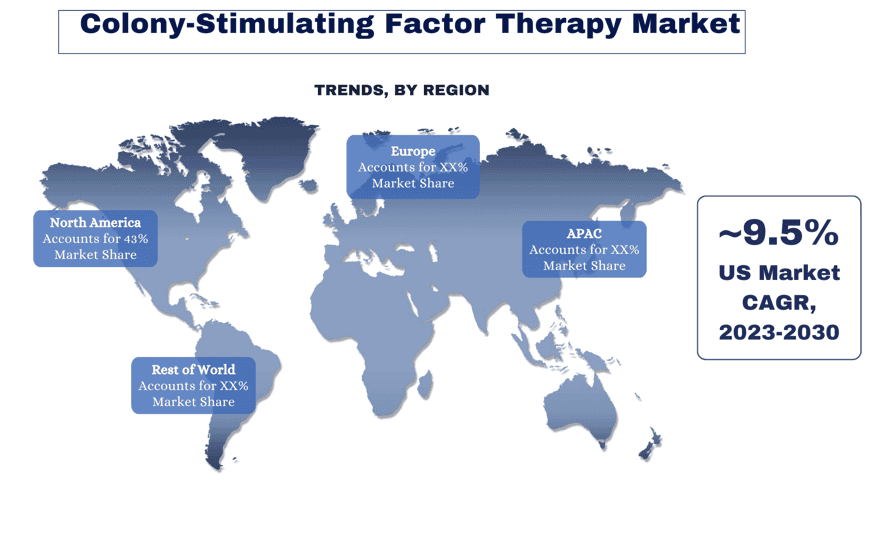
North America is Expected to Grow With Significant CAGR During Forecast Period
Biological Therapies and Immunomodulation: Biological therapies, including CSFs, are increasingly recognized for their immunomodulatory effects beyond their traditional role in stimulating white blood cell production.
Research is focusing on elucidating the mechanisms through which CSFs influence the immune system, including modulation of inflammatory responses, enhancement of antigen presentation, and regulation of immune cell function.
By harnessing the immunomodulatory properties of CSFs, researchers aim to develop novel therapeutic strategies for cancer and autoimmune diseases, as well as explore their potential in immunotherapy combinations.
Long-Acting Formulations and Drug Delivery Innovations:Pharmaceutical companies are investing in the development of long-acting formulations of CSFs to improve patient convenience and treatment adherence.
Novel drug delivery technologies, such as sustained-release formulations, polymer-based implants, and microneedle patches, offer prolonged drug release and reduced dosing frequency.
Long-acting formulations and drug delivery innovations enhance the pharmacokinetic profile of CSFs, providing sustained therapeutic effects while minimizing fluctuations in drug levels.
Colony-stimulating factor therapy Industry Overview
The colony-stimulating factor therapy market is competitive and fragmented, with the presence of several global and international market players. The key players are adopting different growth strategies to enhance their market presence, such as partnerships, agreements, collaborations, new product launches, geographical expansions, and mergers and acquisitions. Some of the major players operating in the market are Sanofi, Novartis AG, Teva Pharmaceutical Industries Ltd. , Pfizer Inc. , GlaxoSmithKline plc , Dr. Reddy’s Laboratories Ltd. , Amgen Inc. , Merck KGaA , Takeda Pharmaceutical Company Limited , Thermo Fisher Scientific Inc.
Colony-stimulating factor therapy Market News
- In March 2023, Coherus BioSciences received U.S. FDA approval for its pegfilgrastim-cbqv (Udencya), a pegfilgrastim biosimilar for managing febrile neutropenia induced by chemotherapy.
- In September 2022, Spectrum Pharmaceuticals, Inc. received U.S. FDA approval for its ROLVEDON (eflapegrastim-xnst) injection, which is intended to decrease the incidence of infection, as manifested by febrile neutropenia in adult patients with non-myeloid-malignancies-receiving myelosuppressive anti-cancer drugs associated with a clinically significant incidence of febrile neutropenia.
Colony-Stimulating Factor Therapy Market Report Coverage
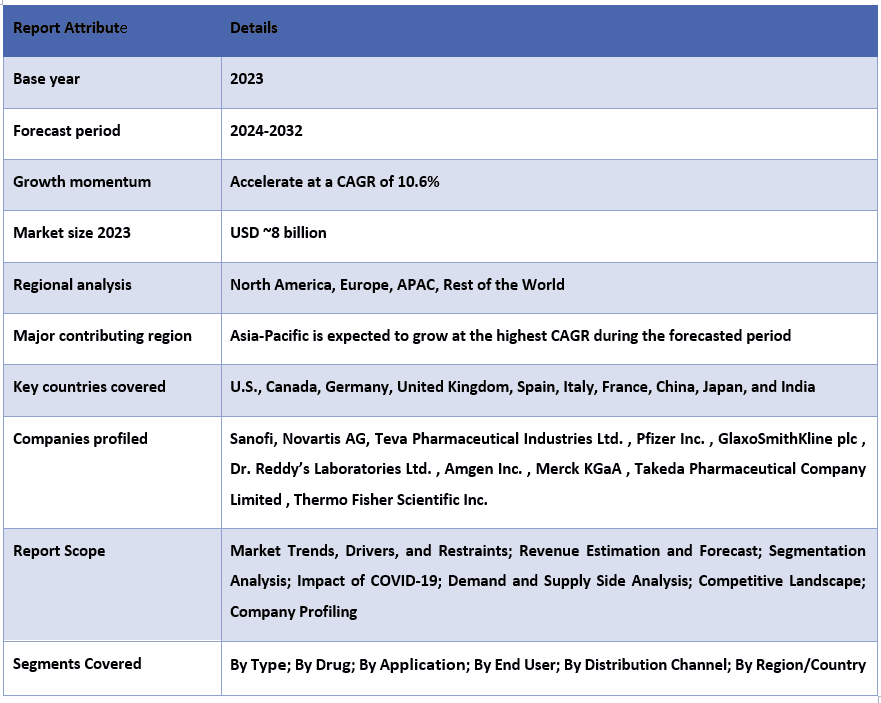
Reasons to buy this report:
- The study includes market sizing and forecasting analysis validated by authenticated key industry experts.
- The report presents a quick review of overall industry performance at one glance.
- The report covers an in-depth analysis of prominent industry peers with a primary focus on key business financials, product portfolios, expansion strategies, and recent developments.
- Detailed examination of drivers, restraints, key trends, and opportunities prevailing in the industry.
- The study comprehensively covers the market across different segments.
- Deep dive regional level analysis of the industry.
Customization Options:
The global colony-stimulating factor therapy market can further be customized as per the requirement or any other market segment. Besides this, UMI understands that you may have your own business needs, hence feel free to connect with us to get a report that completely suits your requirements.
Table of Content
Research Methodology for the Colony-stimulating factor therapy Market Analysis (2024-2032)
Analyzing the historical market, estimating the current market, and forecasting the future market of the global colony-stimulating factor therapy market were the three major steps undertaken to create and analyze the adoption of colony-stimulating factor therapy in major regions globally. Exhaustive secondary research was conducted to collect the historical market numbers and estimate the current market size. Secondly, to validate these insights, numerous findings and assumptions were taken into consideration. Moreover, exhaustive primary interviews were also conducted, with industry experts across the value chain of the global colony-stimulating factor therapy market. Post assumption and validation of market numbers through primary interviews, we employed a top-down/bottom-up approach to forecasting the complete market size. Thereafter, market breakdown and data triangulation methods were adopted to estimate and analyze the market size of segments and sub-segments of the industry pertains to. Detailed methodology is explained below:
Analysis of Historical Market Size
Step 1: In-Depth Study of Secondary Sources:
Detail secondary study was conducted to obtain the historical market size of the colony-stimulating factor therapy market through company internal sources such as annual reports & financial statements, performance presentations, press releases, etc., and external sources including journals, news & articles, government publications, competitor publications, sector reports, third-party database, and other credible publications.
Step 2: Market Segmentation:
After obtaining the historical market size of the colony-stimulating factor therapy market, we conducted a detailed secondary analysis to gather historical market insights and share for different segments & sub-segments for major regions. Major segments are included in the report as type, drug, application end-user and distribution channel. Further country-level analyses were conducted to evaluate the overall adoption of testing models in that region.
Step 3: Factor Analysis:
After acquiring the historical market size of different segments and sub-segments, we conducted a detailed factor analysis to estimate the current market size of the colony-stimulating factor therapy market. Further, we conducted factor analysis using dependent and independent variables such as type, drug, application end-user and distribution channel of the colony-stimulating factor therapy market. A thorough analysis was conducted for demand and supply-side scenarios considering top partnerships, mergers and acquisitions, business expansion, and product launches in the colony-stimulating factor therapy market sector across the globe.
Current Market Size Estimate & Forecast
Current Market Sizing: Based on actionable insights from the above 3 steps, we arrived at the current market size, key players in the global colony-stimulating factor therapy market, and market shares of the segments. All the required percentage shares split, and market breakdowns were determined using the above-mentioned secondary approach and were verified through primary interviews.
Estimation & Forecasting: For market estimation and forecast, weights were assigned to different factors including drivers & trends, restraints, and opportunities available for the stakeholders. After analyzing these factors, relevant forecasting techniques i.e., the top-down/bottom-up approach were applied to arrive at the market forecast for 2030 for different segments and sub-segments across the major markets globally. The research methodology adopted to estimate the market size encompasses:
- The industry’s market size, in terms of revenue (USD) and the adoption rate of the colony-stimulating factor therapy market across the major markets domestically
- All percentage shares, splits, and breakdowns of market segments and sub-segments
- Key players in the global colony-stimulating factor therapy market in terms of products offered. Also, the growth strategies adopted by these players to compete in the fast-growing market
Market Size and Share Validation
Primary Research: In-depth interviews were conducted with the Key Opinion Leaders (KOLs) including Top Level Executives (CXO/VPs, Sales Head, Marketing Head, Operational Head, Regional Head, Country Head, etc.) across major regions. Primary research findings were then summarized, and statistical analysis was performed to prove the stated hypothesis. Inputs from primary research were consolidated with secondary findings, hence turning information into actionable insights.
Split of Primary Participants in Different Regions
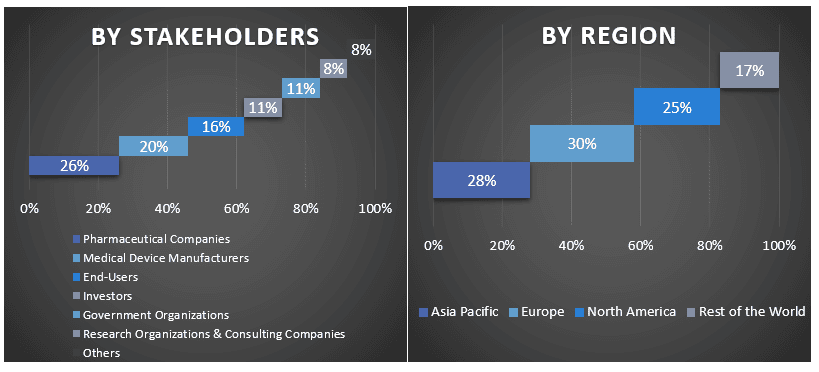
Market Engineering
The data triangulation technique was employed to complete the overall market estimation and to arrive at precise statistical numbers for each segment and sub-segment of the global colony-stimulating factor therapy market. data was split into several segments & sub-segments post studying various parameters and trends in the areas of the as type, drug, application end-user and distribution channel in the global colony-stimulating factor therapy market.
The main objective of the Global Colony-stimulating factor therapy Market Study
The current & future market trends of the global colony-stimulating factor therapy market were pinpointed in the study. Investors can gain strategic insights to base their discretion for investments on the qualitative and quantitative analysis performed in the study. Current and future market trends determined the overall attractiveness of the market at a regional level, providing a platform for the industrial participant to exploit the untapped market to benefit from a first-mover advantage. Other quantitative goals of the studies include:
- Analyze the current and forecast market size of the colony-stimulating factor therapy market in terms of value (USD). Also, analyze the current and forecast market size of different segments and sub-segments
- Segments in the study include areas of the as type, drug, application end-user and distribution channel
- Define and analysis of the regulatory framework for the colony-stimulating factor therapy industry
- Analyze the value chain involved with the presence of various intermediaries, along with analyzing customer and competitor behaviors of the industry
- Analyze the current and forecast market size of the colony-stimulating factor therapy market for the major region
- Major countries of regions studied in the report include Asia Pacific, Europe, North America, and the Rest of the World
- Company profiles of the colony-stimulating factor therapy market and the growth strategies adopted by the market players to sustain in the fast-growing market
- Deep dive regional level analysis of the industry
Frequently Asked Questions FAQs
Q1: What is the current market size and growth potential of the colony-stimulating factor therapy market?
Q2: What are the driving factors for the growth of the colony-stimulating factor therapy market?
Q3: Which segment has the largest share of the colony-stimulating factor therapy market by type?
Q4: What are the emerging technologies and trends in the colony-stimulating factor therapy market?
Q5: Which region will dominate the colony-stimulating factor therapy market?
Related Reports
Customers who bought this item also bought






